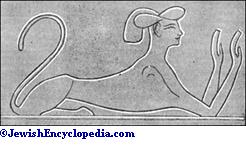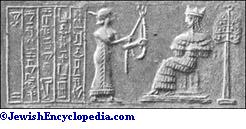Astarte Worship Among The Hebrews
 From Jewish Encyclopedia (1906)
From Jewish Encyclopedia (1906) Astarte Worship Among The Hebrews:

Astarte is the Phenician name of the primitive Semitic mother-goddess, out of which the most important of the Semitic deities were developed. She was known in Arabia as "Athtar," and inBabylonia as "Ishtar." Her name appears in the Old Testament (I Kings xi. 5; II Kings xxiii. 13) as "Ashtoreth," a distortion of "Ashtart," made after the analogy of "Bosheth" (compare Jastrow, in "Jour. Bibl. Lit." xiii. 28, note). Solomon is said to have built a high place to her near Jerusalem, which was removed during Josiah's reform (I Kings xi. 5, 33; II Kings xxiii. 12). Astarte is called in these passages "the abomination of the Zidonians," because, as the inscriptions of Tabnith and Eshmunazer show, she was the chief divinity of that city (see Hoffmann, "Phönizische Inschriften," 57, and "C. I. S." No. 3). In Phenician countries she was the female counterpart of Baal , and was no doubt worshiped with him by those Hebrews who at times became his devotees. This is proved by the fact that Baalim and Ashtaroth are used several times (Judges x. 6; I Sam. vii. 4, xii. 10) like the Assyrian "ilani u ishtarati" for "gods and goddesses."

Astarte, wherever worshiped, was a goddess of fertility and sexual love. A trace of this among the Hebrews appears in Deut. vii. 13, xxviii. 4, 18, where the lambs are called the "ashtarot" of the flock. It is usually assumed that Astarte Worship was always a foreign cult among the Hebrews; but analogy with the development of other Semitic deities, like the Phenician Baal, would lead to the supposition that Astarte Worship before the days of the Prophets may have somewhat prejudiced that of

- E. Meyer, Astarte, in Roscher, Lexikon der Griechischen und Römischen Mythologie;
- Barton, in Hebraica, ix. 133-165, x. 1-74;
- idem, Semitic Origins, ch. vii.;
- W. Robertson Smith, Religion of the Semites, Index.
Categories: [Jewish encyclopedia 1906]
↧ Download as ZWI file | Last modified: 09/04/2022 17:58:59 | 15 views
☰ Source: https://www.jewishencyclopedia.com/articles/2048-astarte-worship-among-the-hebrews.html | License: Public domain
 ZWI signed:
ZWI signed: KSF
KSF